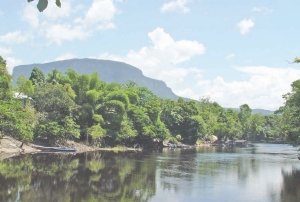Canadian uranium explorer U3O8 Corp. (UWE-V, UTREF-O) believes Guyana’s Roraima basin may one day play a significant role in feeding the world’s growing appetite for clean nuclear power.
U3O8 Corp. describes the basin as a geological look-alike in terms of size, age, composition and nature of basement rocks, to Canada’s Athabasca basin, which contains the world’s largest uranium resource.
An initial resource estimate for the Toronto-based company’s Aricheng North and Aricheng South basement-hosted structures, about 5 km from the Roraima basin, has yielded an indicated resource at a cutoff grade of 0.05% U3O8 of 2.7 million tonnes averaging 0.1% U3O8 for 5.8 million lbs. uranium oxide. The inferred resource contains 645,000 tonnes grading 0.09% U3O8 for 1.3 million lbs. uranium oxide. Mineralization remains open along strike and downdip.
Calling the resource estimate a milestone, president and chief executive Richard Spence noted in a statement that it is the first of the company’s basement-hosted uranium targets to advance to resource definition.
Just two years after going public in December 2006, U3O8 Corp.’s exploration drilling has defined a number of uranium-bearing structures in the basement that could increase the initial resource, the company notes. U308 holds 13,000 sq. km of permitting rights in the basin.
The company believes that Guyana offers the best access to the Roraima basin, which straddles northern Brazil, Guyana and Venezuela.
“Guyana offers the most viable entry to the Roraima basin compared with the politically challenging situation in Venezuela, while in Brazil, uranium is considered a strategic commodity that can only be explored by a state entity,” says the company’s website.
Previously known as British Guiana, Guyana is the only state in South America that is a member of the Commonwealth of Nations. Lying on the northern coast of the continent, the 215,000-sq.-km nation is bordered to the east by Suriname, to the south and southwest by Brazil, to the west by Venezuela and to the north by the Atlantic Ocean.
Between 2007 and 2008, U308 drilled 93 holes for 17,355 metres at Aricheng South and 92 holes for 15,451 metres at Aricheng North.
Uranium mineralization at Aricheng South and Aricheng North lies within fracture zones and breccias within the Kurupung batholith in the basement.
“Mineralization at Aricheng South and Aricheng North remains open for expansion and further drilling has the potential to considerably increase this initial resource figure,” Spence said. “Our focus is now to determine whether other mineralized structures in the Kurupung batholith can contribute to a significantly larger uranium resource.”
The Aricheng South structure strikes east and dips about 60 to the north. Drilling has marked uranium mineralization over a 320- metre strike length. The deposit is still open along strike to the west, continues to a maximum depth of 230 metres below surface and remains open at depth.
The Aricheng North structure strikes northeast and dips about 75 to the northwest. Drilling has delineated mineralization over a 750- metre strike distance, where it remains open along strike to the southwest. The deposit was tested to a maximum depth of about 190 metres below surface and remains open at depth.
The junior explorer recently traded at about 33.5¢ per share and has a 52-week range of 17¢-$1.20. The company has 17 million shares outstanding.
U308 has about $10 million in cash and Canadian chartered bank-backed guaranteed investment certificates.


Be the first to comment on "U308 Reports Uranium Resource In Guyana"